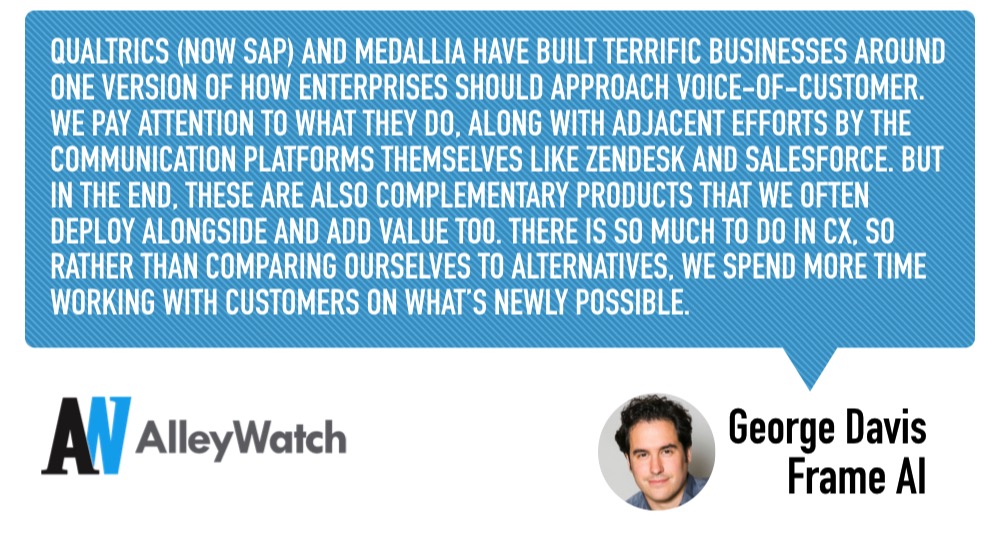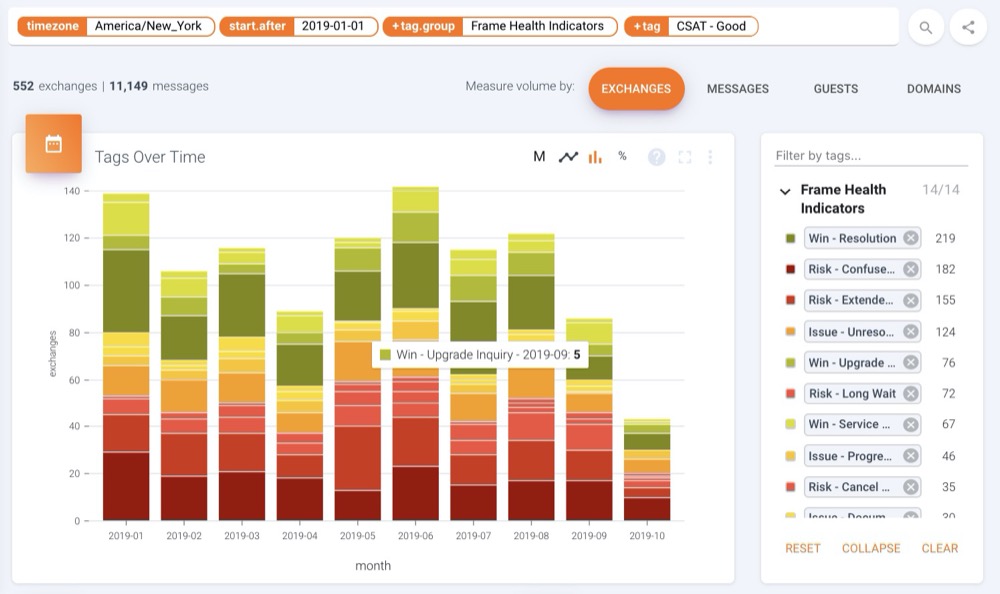73% of all people point to customer experience (CX) as a determining factor in their purchasing decision. Frame AI challenges the status quo through its Voice-of-Customer data platform that helps companies identify, prioritize, and take proactive action to address drivers of customer experience, in real-time and across all channels. Through machine learning and AI built into the platform, CX teams can discover specific pain points, uncover emerging themes, and clean up data in a fraction of the time it would take for these issues to be discovered otherwise.
AlleyWatch sat down with CEO and Founder George Davis to discuss the CX solutions market, fundraising in these uncertain times, and Frame AI’s expansion plans.
Who were your investors and how much did you raise?
We just raised our $6.3M Series A, led by G20 Ventures of Boston and here in NYC. Along with our Seed, which was led by FirstMark, this brings total Frame AI funding to over $10M.
Tell us about the product or service that Frame AI offers.
Our product suite, the Frame AI Hub, operates as both an early warning and continuous monitoring system for Customer Experience (CX) leaders – where CX often includes support, success, services, and product development. It consolidates data from CRMs, call centers, helpdesks, and other communication channels. Then we use machine learning to prioritize attention around emerging themes at the conversation, account, or segment levels.
 What inspired the start of Frame AI?
What inspired the start of Frame AI?
My sister’s wedding gave me an excuse to spend a couple of months in Southeast Asia, and while I was there, I became obsessed with how willing customers were to chat with businesses in the mobile-first world. We toured a furniture factory with a literal boiler room full of people using a system of index cards and dozens of phones, with personal WhatsApp accounts, to manage support and logistics because it was the best way to keep up with their customers.
After I returned to the US, I realized that this wasn’t about chat—it was about businesses around the world competing less on price and more on a strong customer experience. To do this, they are racing to communicate more frequently and more effectively. As a data nerd, I wondered how busy teams could possibly make sense of so many open-ended conversations with customers. When I found the answer is that they really can’t, I realized there was something really useful that needed to be built!
How is Frame AI different?
Voice-of-Customer (VoC) has been a buzzword for some time, but it typically means sending surveys and piecing together broad trends on a monthly or quarterly basis. Our mission is to make the customer’s voice an effective operational tool. We can recognize emerging themes as they happen and on the communication channels customers already use, which allows us to propose actions at the individual user, corporate account, or entire segment level that save and improve customer relationships.
When we’re connected to more of the channels used by success, support and account management teams, we can help retain customers by bringing transparency and alerting across the whole surface. This is especially important, and especially challenging, for B2B companies with subscription models that depend on customer retention. B2B companies often have multiple segments of customers with different default means of communication. Building on the complexity, each individual customer relationship may have multiple customer-facing functions engaging with a broad group of customer stakeholders, from decision-makers to daily users. With many moving pieces, it’s easy for important details to fall through the cracks and damage a relationship.
What market does Frame AI target and how big is it?
The market for CX solutions is huge and expanding rapidly. Incumbents like Salesforce, Zendesk, and Medallia have built billion-dollar businesses by making existing CX operations more efficient. They are being challenged by fast-growing next-gen platforms like NYC’s own Kustomer and Braze, which have added a focus on forming a unified view of a customer journey across many touchpoints.
However, Frame AI fills a critical gap by making the actual substance of conversations part of that unified customer view and a tool for improving experience. We are relevant to CX leaders at any company responsible for thousands of customer conversations a month, especially if they take place across multiple channels.
Who do you consider to be your primary competitors?
Qualtrics (now SAP) and Medallia have built terrific businesses around one version of how enterprises should approach Voice-of-Customer. We pay attention to what they do, along with adjacent efforts by the communication platforms themselves like Zendesk and Salesforce. But in the end, these are also complementary products that we often deploy alongside and add value too. There is so much to do in CX, so rather than comparing ourselves to alternatives, we spend more time working with customers on what’s newly possible.
What’s your business model?
Frame AI is an enterprise SaaS platform, which means we offer supporting service and custom deployments in addition to the self-service trial available from our website. Because we’re designed to improve coordination across siloed operational teams, we’ve opted to avoid a seat-based model. Instead, we charge based on the data volume we analyze, which helps us align with the value we are adding and leave the customer room to benefit from team collaboration.
As a data analysis platform, we are also perfectly positioned to help companies measure the ROI we produce. We’re working to make it possible for teams to invest in CX tools and processes on the basis of quantified costs and benefits, starting with ourselves.
What was the funding process like?
Surprisingly organic. G20 actually reached out during a period where we were heads-down on growth and not yet planning our raise. Bill Wiberg had a strong thesis in the space and became a great discussion partner as we worked through our first growing pains. John Elton of Greycroft had participated in our Seed check (led by Firstmark) and has been a real partner throughout our lifetime. When we decided it was time to expand the team, both were there with clean terms and obvious value add.
What are the biggest challenges that you faced while raising capital?
No one could possibly have anticipated the impact of COVID-19, and we definitely felt the anxiety of trying to close our round in mid-March. I’m grateful to work with investors, teammates, and customers who see adversity as a chance to focus on the best possible version of the future rather than being paralyzed by the uncertainty of today.
What factors about your business led your investors to write the check?
The CX tools market is growing but also crowded. Our investors saw that we have a truly unique and substantive approach to that market, and we really respond to frustrations that enterprises have in modernizing their CX operations, particularly in B2B. They also saw that I’m privileged to work with an incredible team. Together, we have built a platform that analyzes conversations between millions of customers and over 10,000 agents per month, and we won business from world-class companies like Fastly and driven 10x YoY revenue, all with a lean, single-digit headcount.
What are the milestones you plan to achieve in the next six months?
Like many teams, we are revising our sales strategy rapidly to be responsive and empathetic to the new challenges we are all facing. With that said, it’s the right time to focus on our team, product, and community. Our priorities right now are to (a) be as helpful as possible to our existing customers and community in managing ongoing change and (b) grow and train our own customer-facing teams (marketing, sales, and success – we’re hiring!).
What advice can you offer companies in New York that do not have a fresh injection of capital in the bank?
I wouldn’t presume to advise, but I’ll share my own optimism about New York’s collective ingenuity over the coming weeks of distancing, and boldness in the recovery that follows. This is a city of strong relationships. Let’s work together to support our teams and each other first, find new ways to do business in this environment, and remember the sheer amount of hustle in this city. Talk to your customers and find out what they need!
Right now, there are new needs from front line responders and critical services. We’ve had an opportunity to work with some of our health and infrastructure companies on measuring and developing operations for new spikes of requests from their customers. If you are a New York business or other organization whose communications have suddenly become critical and overloaded, we’d love to see how we can help pro bono during this time.
Right now, there are new needs from front line responders and critical services. We’ve had an opportunity to work with some of our health and infrastructure companies on measuring and developing operations for new spikes of requests from their customers.
Where do you see the company going now over the near term?
In the near term, we’ll be continuing to lean into our focus on operationalizing the customer voice. Analytics tools always risk being yet another pane of glass, overloading their users with restated information rather than calls to action. The recently launched Frame AI Checklist is an automatically curated set of proposed actions for CX leaders to review and enables them to take action in response to the customer voice.
What’s your favorite restaurant in the city?
Jessi’s Coffee on Bushwick Ave – featuring the delicious breakfast wrap that is still $4 after 10 years, and doubles as lunch for the thrifty founder. Or else Saluggi’s pizza on Church, where together with my cofounder Brandon I’ve chewed through many critical business decisions over a large cheese, mushroom, and olive pie.
You are seconds away from signing up for the hottest list in New York Tech! Join the millions and keep up with the stories shaping entrepreneurship. Sign up today




